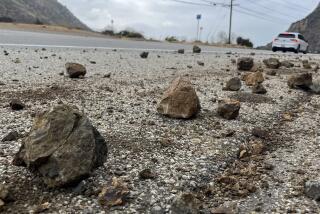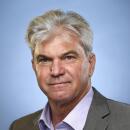Science Sends Us a Warning
- Share via
There will be a great earthquake. The great theater full up will be ruined. Darkness and trouble in the air, on sky and land when the infidel calls upon God .
--Nostradamus, 1555
California’s next great earthquake may take place while you are reading this .
--Sunset Books, 1964
We expect an earthquake between 5.5 and 6.0 to occur in Parkfield in the next 72 hours .
--The U.S. Geological Survey, October, 1992
Earthquake predictions occur in California almost as often as big earthquakes. That there rarely is any correlation between predicted quakes and actual quakes presents a problem for seismologists. Every time they forecast an earthquake that fails to strike, or are surprised by one they did not see coming, public confidence in the next prediction diminishes.
It’s the boy who cried wolf all over again, or so it would appear. Yet, while that familiar fable teaches mainly about the dangers of false warnings, it presents an equally pertinent moral for those who would disregard earthquake forecasts because of their poor track record:
In the end, after all, there actually was a wolf.
*
The latest earthquake prognosis came Monday. A team of top-flight scientists, assessing the implications of quakes this year in the California desert, concluded in a 42-page report that a big one, if not the Big One, is more likely now than previously thought. They spoke of “stress redistribution” near Landers, and of “a ripeness for failure” along the southern San Andreas.
The reaction was predictable--scary headlines, swamped hot lines. Still, for all the attention it generated, the report is something of a disappointment to read. It is loaded with qualifications, the words if and unknown running amok through the text. In one passage, the scientists calculate an almost 50-50 chance of a major quake in five years; but in another, they note “the most probable outcome” is that no such event will occur. The most absolute statement in the report is this: “The conclusions of this report underscore the plausibility of large damaging earthquakes affecting metropolitan areas of Southern California.”
You will note it does not say exactly where. You will note it does not say when.
The document reflects a shift in strategy among earthquake scientists. Frustrated by an inability to discover methods for precise predictions, they’ve turned toward assigning probabilities to various earthquake scenarios. “Betting odds,” as the report calls them. Of course, there is a big difference between predictions and probabilities.
Russian roulette players can say there’s a one-in-six chance of blowing their brains out each time the trigger is squeezed--that’s probability. But they cannot predict with any certainty whether this will occur with the next trigger pull, or 60 trigger pulls. This unpredictability, as anyone who saw the movie “The Deer Hunter” knows, is what makes Russian roulette so exciting. It is also what lends a certain sparkle to life down here: Who knows? California’s next great earthquake might take place while you are reading this. . . .
*
We should not blame the seismologists for their imprecision. It’s a young science, filled with internal disagreement over the most basic questions. Certainly it would be great if the scientists were able to tell us more, to let us know just when to run, duck or tie up the boats in Idaho. They can’t, though, and in the interim I’d rather have the best available information, betting odds even, than nothing.
We also should not chase them into hiding with ridicule. These earthquake predictors are going through the painful process of finding their way in public and someday they may start hitting the mark with more regularity. “In order to progress,” the late Richard Feynman, Caltech’s brilliant physicist, has written about scientists in general, “we must recognize our ignorance and leave room for doubt. . . . Permit us to question--to doubt--to not be sure.”
And anyway, anyone scared by this new report probably should not be living in California in the first place, for in the end it tells only what we knew before: the Big One is coming. Or better, the Big One is coming, probably. And the concluding advice from this forecast is the same as all those which preceded it: Bolt down the house, stock water and batteries, don’t linger beneath overpasses.
And stay away from Parkfield.
More to Read
Sign up for Essential California
The most important California stories and recommendations in your inbox every morning.
You may occasionally receive promotional content from the Los Angeles Times.











